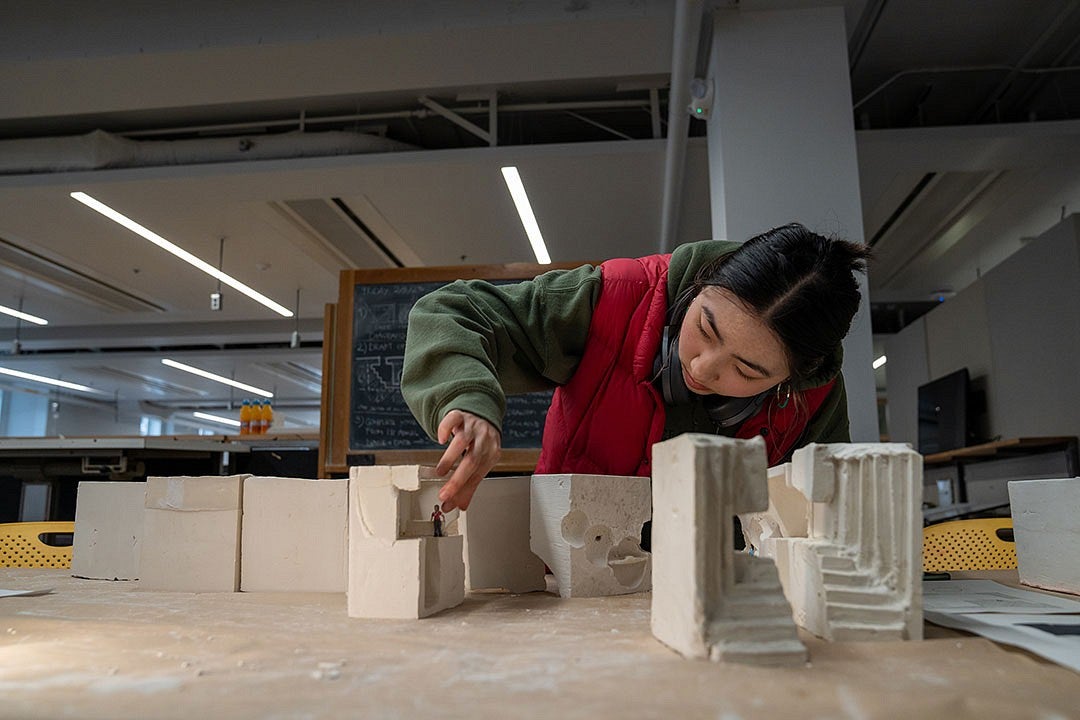Art studio and workshop activities often involve materials and processes that can pose chemical, physical, and health hazards. The Art Safety Program supports a safe creative environment by providing guidance on the use of chemicals, tools, and equipment in studios and workshops.
Everyone who works in a studio -- students, faculty, staff, and visitors – shares responsibility for safety. Our goal is to minimize risks through education, safe work practices, and hazard controls.

Key Responsibilities
- Maintain an up-to-date chemical inventory.
- Participate in annual safety inspections and address findings.
- Provide training on studio-specific hazards and safe work practices.
- Document training.
- Ensure PPE and safety equipment are available and used correctly.
- Report hazards or incidents.
- Follow established safety practices and use required PPE.
- Review Safety Data Sheets before using chemicals or hazardous materials.
- Report unsafe conditions or incidents.
- Keep workspaces clean and organized.
Key Safety Practices
Identify Materials and Processes
Know what you're working with and how you'll use it.
Understand Hazards
- Review potential risk for the materials and processes you work with. Read about common chemical and physical hazards and studio-specific hazards.
- Check Safety Data Sheets for health and safety information before you start working.
- Learn to identify GHS pictograms and other hazard labels.
- Be aware of signs of exposure such as: skin rash, eye irritation, dizziness, headaches, or coughing.
Use Proper Controls and PPE
- Work in ventilated areas.
- Use fume hoods or local exhaust for soldering, etching, or spraying.
- Keep flammable materials away from open flames and hot tools.
- Use wet methods or local exhaust to control dust.
- Wear appropriate PPE.
Store and Dispose of Materials Properly
- Store chemicals in labeled, closed containers.
- Label waste containers as soon as accumulation starts.
- Use UO official hazardous waste tags.
- Request pickup via from the Hazardous Materials team.
Maintain a Safe Workplace
- Clean work surfaces regularly to prevent buildup of hazardous residues.
- Never eat or drink in work areas.
Chemical Hazards
Hazard | risk |
|---|---|
Dyes and Pigments (may contain heavy metals or toxins) | Dust may irritate lungs |
Paints and Solvents (e.g. oil, acrylic, varnishes, thinners) |
|
Ceramics and Glazes (e.g. lead, cadmium, manganese, and other metals) |
|
Photography Chemicals (e.g. developers, fixers, and toners) |
|
Jewelry and Metalsmithing Materials (e.g. acids, flux, patinas, metal dusts, soldering fumes) |
|
Physical Hazards
Hazard | Risk |
|---|---|
Kilns and Furnaces |
|
Sharp Tools (e.g. chisels, saw blades, glass cutters, files, burs) |
|
Machinery (e.g. pottery wheels, presses, rolling mills, polishing wheels, buffers) | Entanglement |
Dust (e.g. clay, plaster metal dust) |
|
Noise (e.g. hammering, grinding, polishing) |
|
Personal Protective Equipment (PPE)
Common types of PPE and situations when they may be used in the studio.
- Eye Protection - Safety glasses or goggles for cutting, grinding, soldering.
- Gloves - Nitrile for chemicals, heat-resistant for kiln work, cut-resistant for sharp tools.
- Respiratory Protection - Dust masks or respirators when sanding, grinding, polishing, or working with power tools. UO employees must contact the UO Respiratory Protection Program before wearing respiratory protection.
- Hearing Protection - Earplugs or earmuffs for loud tools or machinery. If you work with tools or machinery that generates loud noise, you may qualify for support from the UO Hearing Conservation Program. This program helps prevent occupational hearing loss by providing monitoring and protective strategies.
- Protective Clothing - Aprons or closed-toe shoes. Avoid loose clothing, dangling hair or jewelry.
Ergonomics and Physical Strain
Common types of physical strain in the studio include repeated motions such as pottery throwing, weaving, painting, or carving. These can lead to repetitive strain injuries or cumulative trauma disorders. Proper posture, adjustable workstations, and rotating tasks can reduce strain.
UO employees can request an ergonomic assessment of your environment. The Lab Ergonomics and Ergonomics pages provide tips and guidance on setting up a safer, more comfortable workspace and reducing risk from injury.
Emergency Procedures
Emergency procedures and planning information are available on the Emergency Procedures page. Chemical spill or exposure information is on the Lab Incident Response page.
Questions?
Contact the Lab and Research Safety team.
